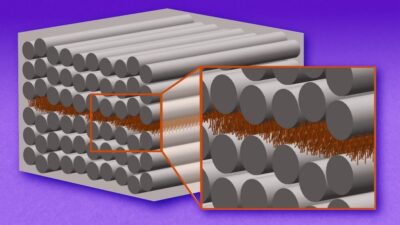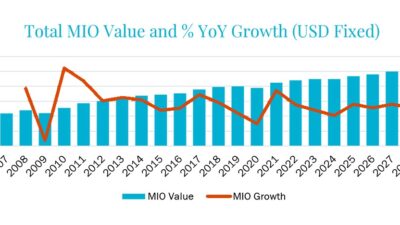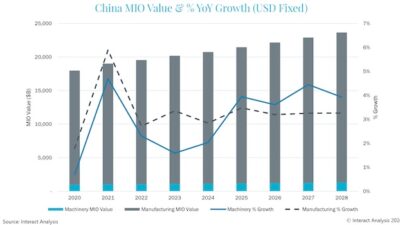Servotronix sensAR is the new magnetic absolute rotary encoder developed by Servotronix. It achieves the high resolution and accuracy of optical absolute encoders in a more compact, robust, and durable product. The encoder’s strength stems from a nonperiodic pattern and a patented method of signal evaluation to generate Gray code and high-resolution absolute positions from one circular track.

Servotronix developed a new magnetic absolute rotary encoder, the Servotronix sensAR rotary encoder, to overcome many of the disadvantages of conventional absolute encoders.
The Servotronix encoder design has a number of permanent magnets of different sizes positioned along the outer edge of the encoder disk in one circular track, forming a magnetic code track whose pattern is nonperiodic.
Magnetic (Hall) sensors are fixed to a static part of the encoder, spaced equidistantly from each other, arranged concentrically and in close proximity to the magnetic code track.
A patented algorithm in the Servotronix design generates a Gray code with a maximum number of positions for a given number of sensors from a nonperiodic pattern of a single magnetic code track.
In addition, the sensors’ analog output signals directly provide a high-resolution absolute position, without needing additional incremental readings. The sensors produce electrical signals proportional to the strength of the magnetic field generated by the facing magnet. These analog signals are first digitized by comparing them to a threshold value, thus generating a Gray code that describes an absolute position at a low resolution. A configuration of seven sensors and seven magnets, for example, creates a Gray code that identifies 98 positions.
To achieve a higher absolute resolution, an additional patented method for signal evaluation is applied. Two analog signals are associated with each Gray code according to a predefined signal table. The absolute position of the disk corresponds to the associated position value in a prerecorded position table for the analog signal whose value is closest to the threshold.
When put into practice, the Servotronix technology achieves a resolution of 20 bits using a 12-bit analog-to-digital converter and a configuration for seven sensors.
First in the rotary encoder series
The first magnetic absolute encoder in the Servotronix sensAR rotary encoder series offers a 20-bit resolution and an accuracy of ±0.02 degrees (±72 arcsec). The encoder initially is available with a 36 mm diameter and a height of 28 mm.
Simplicity is the main advantage of this new encoder, which generates a Gray code from one track, unlike other absolute encoders that need at least two tracks and an array of custom-designed sensors. High resolution is achieved by means of a patented signal evaluation, instead of the high-resolution incremental readings typically used in absolute encoders that make such devices larger and more complex. Moreover, the mechanical design, which uses off-the-shelf Hall sensors and does not require customized miniature sensor arrays, results in a cost-effective encoder.
Magnetic technology combined with a mechanically simple design gives the sensAR encoder compactness, robustness, and durability. Featuring only few mechanical parts and no optical components, sensAR encoders are less sensitive to contamination and can operate reliably in dirty, dusty, or humid environments, and at temperatures ranging from -20 C to 115 C. These encoders can also accommodate mechanical tolerance deviations with a permissible axial and radial motion of the motor shaft of ±0.5 mm and ±0.025 mm, respectively.
By eliminating optical components and bearings, the durability of the encoder is high, and there is no need for maintenance. Even at rotational speeds up to 10,000 rpm and angular acceleration of up to 100,000 rad/s2, sensAR has a long service life (MTBF @ 80 C: 788,400 hr).
The ruggedness of the sensAR encoders make them particularly reliable in motor-feedback applications that are exposed to severe shock, for example due to emergency braking, or high vibration.
– Dr. Markus Erlich is vice president marketing, Servotronix Motion Control Ltd. Edited by Mark T. Hoske, content manager, CFE Media, Control Engineering, [email protected].
ONLINE extra
See related Technology Update in the May 2015 print and digital edition of Control Engineering, and linked below, for additional information and images: "Reinventing absolute rotary encoders."



